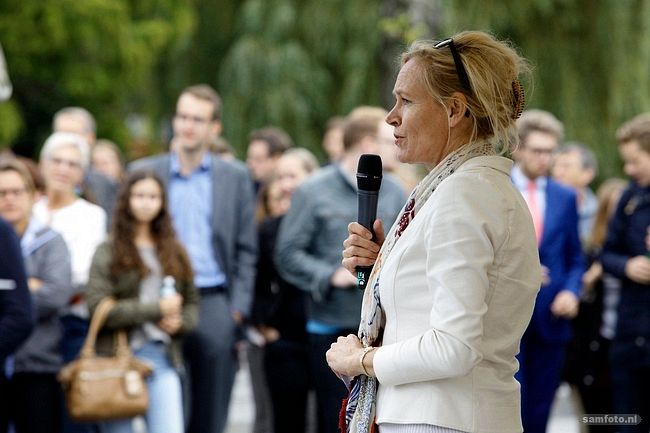Up went the black and orange PULSE flag marking the start of construction. After ten years in development, a festive lunchtime event finally celebrated breaking ground next to the future inter-faculty educational centre’s site between the Mechanical, Maritime & Materials (3mE) and Industrial Design (IO) faculties.
Executive Board member Anka Mulder hoisted the flag and opened the celebration for staff, students and representatives from Delft municipality on October 3, 2016. Scheduled to open during the 2017-2018 academic year, PULSE will be a new heart on campus equipped with classrooms of varying sizes and equipment to practise, unite, learn, share and explore. Mulder explained that PULSE will address increases in student numbers, new developments in education and cultural shifts. Specialised faculty cultures are dissolving in the face of multidisciplinarity and TU Delft is accommodating it. A two storey bike storage building with a bike repair facility and a place to grab a coffee is also planned on the opposite side of the square.
This project is remarkable for the broad participation of the campus community. The whole co-creation process has incorporated the community’s different perspectives and much TU Delft in-house expertise. Andy van den Dobbelsteen, professor of Climate Design and Sustainability at the Architecture and the Built Environment faculty is sustainability supervisor on the project. He stressed the building’s net zero energy credentials, achieved by using smart first principles before applying other technical solutions.
“We looked at the architecture, the layout, the zoning in the building, compartmentalisation,” said Dobbelsteen, “and, though it has a lot of glass, we optimised the building’s skin, all to reduce the energy demand as the first step.”
It won’t be a sealed passive hi-tech box either. A building with lots of coming and going has to be dynamic with responsive active systems. He underlines that it’s the very first time we have an integrated design for a building with TU Delft staff involved, also including students as important end users shaping the spaces they will occupy.
Student Council representative and ORAS secretary Natalie Brik said, “I think the project’s integrative approach, taking into account the whole context around the building will make it attractive.”
“Because of the long consultation time many negative aspects have been adequately tackled with all parties understanding each other’s standpoints,” said outgoing secretary for 2015-2016, Eva Rikkers.
The strategic plan for the campus envisages more of these buildings at different sites. Dobbelsteen believes that applying the model for TU community consultation in these future projects will better express the university’s innovative capacity and sustainability ambitions.



Comments are closed.